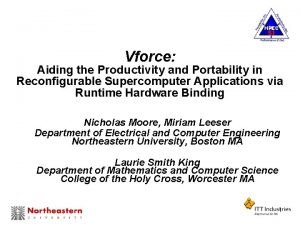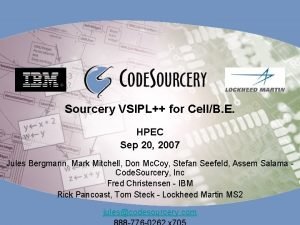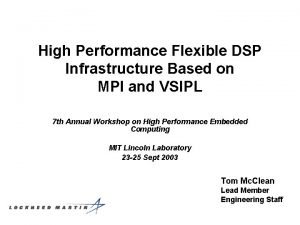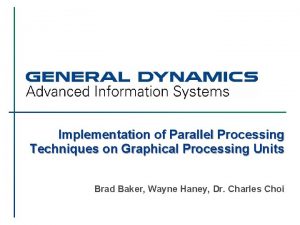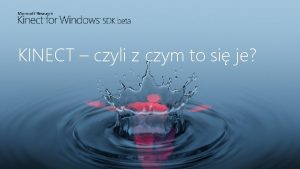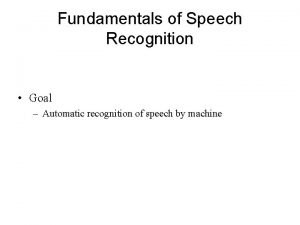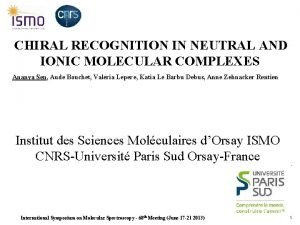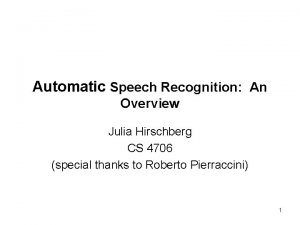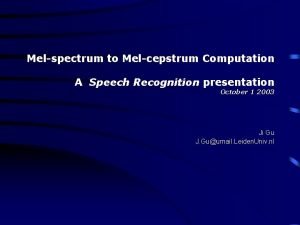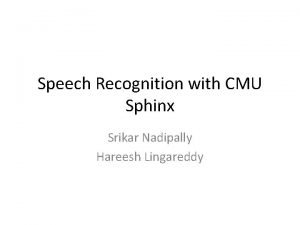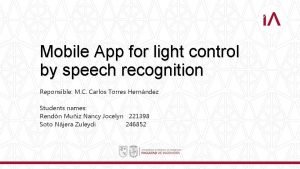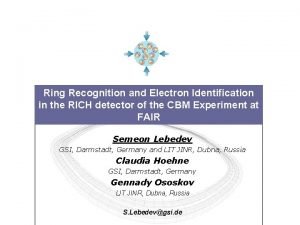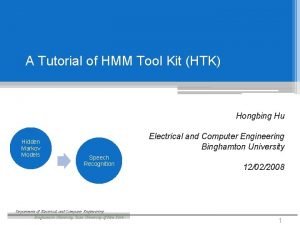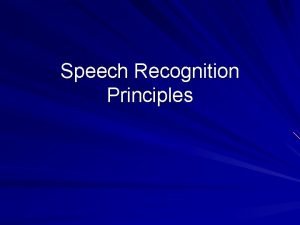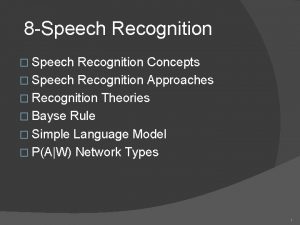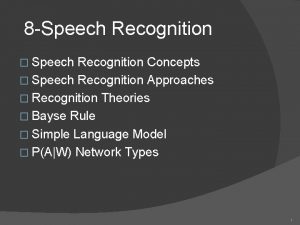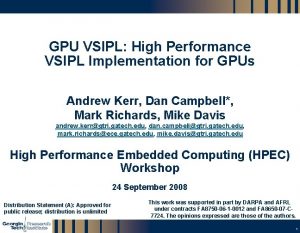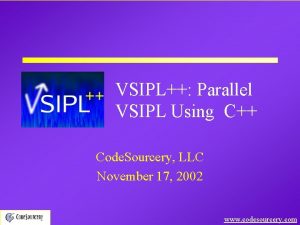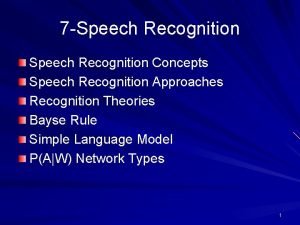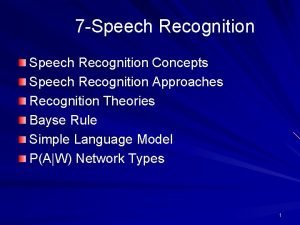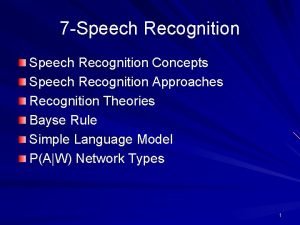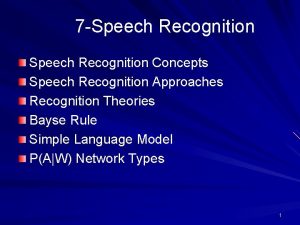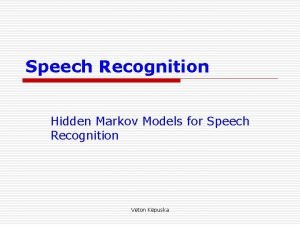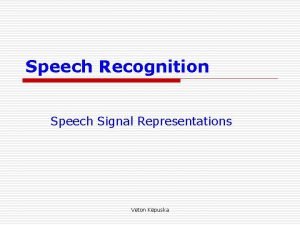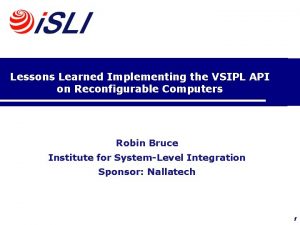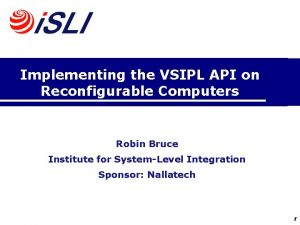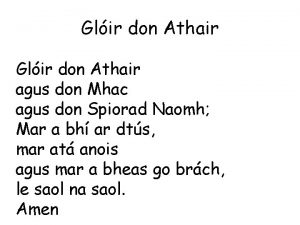Implementing a Speech Recognition Algorithm with VSIPL Don






























- Slides: 30

Implementing a Speech Recognition Algorithm with VSIPL++ Don Mc. Coy, Brooks Moses, Stefan Seefeld, Justin Voo Software Engineers Embedded Systems Division / HPC Group September 2011

Objective VSIPL++ Standard: n Standard originally developed under Air Force and MIT/LL leadership. n Code. Sourcery (now Mentor Graphics) has a commercial implementation: Sourcery VSIPL++. n Intention is to be a general library for signal and image applications. n Originating community largely focused on radar/sonar. Question: Is VSIPL++ indeed useful outside of radar and radar-like fields, as intended? n Sample application: Automatic Speech Recognition © 2011 Mentor Graphics Corp. D. M. , Implementing a Speech Recognition Algorithm with VSIPL++, September 2011 www. mentor. com

Automatic Speech Recognition This presentation focuses on two aspects: n Feature Extraction n “Decoding” (a. k. a. Recognition) We will compare to existing Matlab and C code: n PMTK 3 (Matlab modeling toolkit) — written by Matt Dunham, Kevin Murphy and others n MFCC code (Matlab implementation) — written by Dan Ellis n HTK (C-based research implementation) — from Cambridge University Engineering Department (CUED) © 2011 Mentor Graphics Corp. D. M. , Implementing a Speech Recognition Algorithm with VSIPL++, September 2011 www. mentor. com

Implementing a Speech Recognition Algorithm with VSIPL++ “DECODING” © 2011 Mentor Graphics Corp. www. mentor. com

Decoding n Hidden Markov Models (HMM) a 22 a 12 s a 33 a 23 ih "six" a 44 a 34 a 24 k a 55 a 34 s a 35 Observation sequence o 1 o 2 o 3 o 4 o 5 o 6 © 2011 Mentor Graphics Corp. D. M. , Implementing a Speech Recognition Algorithm with VSIPL++, September 2011 www. mentor. com o 7

Decoding n Gaussian Mixture Models — Trained on acoustic data to account for variation — Diagram shows representation of PDF for a two-variable MFCC © 2011 Mentor Graphics Corp. D. M. , Implementing a Speech Recognition Algorithm with VSIPL++, September 2011 www. mentor. com

Decoding n We wish to find the highest probability word yn from a sequence of feature vectors O = { o 1, o 2, … on }, so we maximize (over all words) the a posteriori probability P ( yn | O ) n Using Bayes rule, we find it is sufficient to calculate the log-likelihood log p (O | yn) + log P (yn ) Likelihood of a word with a given set of model parameters © 2011 Mentor Graphics Corp. D. M. , Implementing a Speech Recognition Algorithm with VSIPL++, September 2011 www. mentor. com

Decoding Implementation n Matlab and VSIPL++ code – PMTK 3 hmm. Filter() function Matrix<T> AT = transmat. transpose(); alpha = T(); normalize(init. Dist * softev. col(0), alpha. col(0), scale(0)); for (length_type t = 1; t < tmax; ++t) normalize(prod(AT, alpha. col(t-1)) * softev. col(t), alpha. col(t), scale(t)); T eps = std: : numeric_limits<T>: : epsilon(); loglik = sumval(log(scale + eps)); scale = zeros(T, 1); AT = transmat'; alpha = zeros(K, T); [alpha(: , 1), scale(1)] = normalize(init. Dist(: ). * softev(: , 1)); for t=2: T [alpha(: , t), scale(t)] = normalize((AT * alpha(: , t-1)). * softev(: , t)); end loglik = sum(log(scale+eps)); © 2011 Mentor Graphics Corp. D. M. , Implementing a Speech Recognition Algorithm with VSIPL++, September 2011 www. mentor. com

Decoding Implementation n Matlab and VSIPL++ code – PMTK 3 hmm. Filter() function Matrix<T> AT = transmat. transpose(); alpha = T(); normalize(init. Dist * softev. col(0), alpha. col(0), scale(0)); for (length_type t = 1; t < tmax; ++t) normalize(prod(AT, alpha. col(t-1)) * softev. col(t), alpha. col(t), scale(t)); T eps = std: : numeric_limits<T>: : epsilon(); loglik = sumval(log(scale + eps)); scale = zeros(T, 1); AT = transmat'; alpha = zeros(K, T); [alpha(: , 1), scale(1)] = normalize(init. Dist(: ). * softev(: , 1)); for t=2: T [alpha(: , t), scale(t)] = normalize((AT * alpha(: , t-1)). * softev(: , t)); end loglik = sum(log(scale+eps)); © 2011 Mentor Graphics Corp. D. M. , Implementing a Speech Recognition Algorithm with VSIPL++, September 2011 www. mentor. com

Decoding Implementation n Similar line counts for both Matlab and VSIPL++ — VSIPL++: 30 — Matlab: 21 30 25 20 15 10 5 0 SV++ Matlab * generated using David A. Wheeler's 'SLOCCount'. © 2011 Mentor Graphics Corp. D. M. , Implementing a Speech Recognition Algorithm with VSIPL++, September 2011 www. mentor. com

Decoding Implementation n Sourcery VSIPL++ Performance 1, 2 1 Millions of Log-Likelihoods (Models) 5 -State HMM 0, 8 Intel CUDA 0, 6 Cell 0, 4 0, 2 0 3 4 5 6 7 8 9 10 11 12 13 14 Number of Frames (2^N) © 2011 Mentor Graphics Corp. D. M. , Implementing a Speech Recognition Algorithm with VSIPL++, September 2011 www. mentor. com

Decoding Implementation Additional Parallelization Strategies n Custom kernels (GPU, Cell) — Include user-written low-level kernels for key operations — Pack more operations into each invocation — Take advantage of overlapped computations and data transfers n Maps — Distribute VSIPL++ computations across multiple processes — Explicit management of multicore/multiprocessor assignment © 2011 Mentor Graphics Corp. D. M. , Implementing a Speech Recognition Algorithm with VSIPL++, September 2011 www. mentor. com

Implementing a Speech Recognition Algorithm with VSIPL++ FEATURE EXTRACTION © 2011 Mentor Graphics Corp. www. mentor. com

Feature Extraction n Speech signals – the word “four” and its spectrogram . FFT FFT . . © 2011 Mentor Graphics Corp. D. M. , Implementing a Speech Recognition Algorithm with VSIPL++, September 2011 www. mentor. com

Feature Extraction n Mel-frequency Cepstral Coefficients — 13 coefficients, one of which is overall power across all bands — 13 delta coefficients — 13 delta-delta, or ‘acceleration’ coefficients n Result: 39 -element “feature” vector for each timeslice — A 16 k. Hz signal chopped into 1024 samples with 50% overlap yields a feature vector every 32 ms. — Each second of speech gives about 31 feature vectors. n Steps: — — Pre-emphasis FFT Filter bank (spectral warping) DCT © 2011 Mentor Graphics Corp. D. M. , Implementing a Speech Recognition Algorithm with VSIPL++, September 2011 www. mentor. com

Feature Extraction n Pre-emphasis — High-pass FIR filter: H(z) = 1 – 09. 5 z-1 — Increases recognition accuracy by leveling the energy present in across frequency bands n Framing / Windowing / FFT — Choose offset between frames (30 -50%) — Choose frame length (300 – 1024 samples) n Mel-scale spectral warping — Provides compensation for how the auditory system perceives relative differences in pitch n Discrete Cosine Transform — Final product are the cepstral coefficients © 2011 Mentor Graphics Corp. D. M. , Implementing a Speech Recognition Algorithm with VSIPL++, September 2011 www. mentor. com

Feature Extraction Implementation n VSIPL++ code // Apply a pre-emphasis filter to the input Vector<scalar_f> h(2); h(0) = scalar_f(1); h(1) = scalar_f(-0. 97); Fir<scalar_f> preemp(h, signal_length); preemp(x, y); // Compute the spectrogram of the filtered input Matrix<std: : complex<T> > S = specgram(y, hanning(frame_length), frame_offset); // Integrate into mel bins, in the real domain Matrix<T> A = prod(wts, magsq(S)); // Convert to cepstra via DCT Matrix<T> cepstra = spec 2 cep(A, numceps); © 2011 Mentor Graphics Corp. D. M. , Implementing a Speech Recognition Algorithm with VSIPL++, September 2011 www. mentor. com

Feature Extraction Implementation n VSIPL++ code // Apply a pre-emphasis filter to the input Vector<scalar_f> h(2); h(0) = scalar_f(1); h(1) = scalar_f(-0. 97); Fir<scalar_f> preemp(h, signal_length); preemp(x, y); // Compute the spectrogram of the filtered input Matrix<std: : complex<T> > S = specgram(y, hanning(frame_length), frame_offset); // Integrate into mel bins, in the real domain Matrix<T> A = prod(wts, magsq(S)); // Convert to cepstra via DCT Matrix<T> cepstra = spec 2 cep(A, numceps); © 2011 Mentor Graphics Corp. D. M. , Implementing a Speech Recognition Algorithm with VSIPL++, September 2011 www. mentor. com

Feature Extraction Implementation n A closer look at the spectrogram function Fft<const_Vector, T, std: : complex<T>, 0, by_reference, 1> fft(Domain<1>(N), 1. 0); for (length_type m = 0; m < M; ++m) fft(in(Domain<1>(m * I, 1, N)) * window, S. col(m)); or Fftm<T, complex<T>, col, fft_fwd, by_reference, 1> fftm(Domain<2>(N, M), 1. 0); Matrix<T, Dense<2, T, col 2_type> > tmp(N, M); for (length_type m = 0; m < M; ++m) tmp. col(m) = in(Domain<1>(m * I, 1, N)) * window; fftm(tmp, S); © 2011 Mentor Graphics Corp. D. M. , Implementing a Speech Recognition Algorithm with VSIPL++, September 2011 www. mentor. com

Feature Extraction Implementation n A closer look at the spec 2 cep function (aka the DCT) template <typename T, typename Block> vsip: : Matrix<T> spec 2 cep( vsip: : const_Matrix<T, Block> spec, vsip: : length_type const ncep) { using namespace vsip; Length_type nrow = spec. size(0); Matrix<T> dctm(ncep, nrow, T()); for (length_type i = 0; i < ncep; ++i) dctm. row(i) = cos(i * ramp<T>(1, 2, nrow) / (2 * nrow) * M_PI) * sqrt(T(2) / nrow); return (prod(dctm, log(spec))); } © 2011 Mentor Graphics Corp. D. M. , Implementing a Speech Recognition Algorithm with VSIPL++, September 2011 www. mentor. com

Feature Extraction Implementation n A closer look at the spec 2 cep function (aka the DCT) template <typename T> class Dct { public: Dct(vsip: : length_type const ncep, vsip: : length_type const nfilts) : ncep_(ncep), nfilts_(nfilts), dctm_(ncep, nfilts) { for (vsip: : length_type i = 0; i < ncep; ++i) dctm_. row(i) = cos(i * vsip: : ramp<T>(1, 2, nfilts) / (2 * nfilts) * M_PI) * sqrt(T(2) / nfilts); } template <typename Block> vsip: : Matrix<T> operator()(vsip: : const_Matrix<T, Block> input) { return (vsip: : prod(dctm_, input)); }. . . }; © 2011 Mentor Graphics Corp. D. M. , Implementing a Speech Recognition Algorithm with VSIPL++, September 2011 www. mentor. com

Feature Extraction Implementation n VSIPL++ using the modified DCT implementation Dct<T> dct(numceps, numfilters); . . . // Convert to cepstra via DCT Matrix<T> cepstra = dct(log(A)); © 2011 Mentor Graphics Corp. D. M. , Implementing a Speech Recognition Algorithm with VSIPL++, September 2011 www. mentor. com

Feature Extraction Implementation n Line count comparison* — C++: 63 — Matlab: 63 — VSIPL++: 50 70 60 50 n Performance vs. optimized C (time to process 1000 MFCCs) — C : 1. 1 S — Sourcery VSIPL++: 0. 8 s 40 30 20 10 0 SV++ C * generated using David A. Wheeler's 'SLOCCount'. © 2011 Mentor Graphics Corp. D. M. , Implementing a Speech Recognition Algorithm with VSIPL++, September 2011 www. mentor. com Matlab

Feature Extraction Implementation n Sourcery VSIPL++ performance (FFT version) Millions of Samples/second processed 70 60 50 Intel 40 CUDA 30 Cell 20 10 0 9 11 13 15 17 19 21 Signal length (2^N) © 2011 Mentor Graphics Corp. D. M. , Implementing a Speech Recognition Algorithm with VSIPL++, September 2011 www. mentor. com

Feature Extraction Implementation n Sourcery VSIPL++ performance (multiple-FFT version) Millions of Samples/second processed 70 60 50 Intel 40 CUDA 30 Cell 20 10 0 9 11 13 15 17 19 21 Signal length (2^N) © 2011 Mentor Graphics Corp. D. M. , Implementing a Speech Recognition Algorithm with VSIPL++, September 2011 www. mentor. com

Implementing a Speech Recognition Algorithm with VSIPL++ CONCLUSIONS © 2011 Mentor Graphics Corp. www. mentor. com

VSIPL++ Assessment & Conclusions Benefits of the VSIPL++ Standard n Does not tie the user’s hands with regard to algorithmic choices — Prototyping algorithms is fast and efficient for users n C++ code is easier to read and more compact — Fosters rapid development n Implementers of the standard have the flexibility required to get good performance. — Allows best performance on a range of hardware n Prototype code is benchmark-ready… © 2011 Mentor Graphics Corp. D. M. , Implementing a Speech Recognition Algorithm with VSIPL++, September 2011 www. mentor. com

VSIPL++ Assessment & Conclusions, cont… Potential Extensions to the VSIPL++ Standard n Direct Data Access (DDA) — Already proposed to standards body — Proven useful in the field n Sliding-window FFT / FFTM n DCT and other transforms © 2011 Mentor Graphics Corp. D. M. , Implementing a Speech Recognition Algorithm with VSIPL++, September 2011 www. mentor. com

© 2011 Mentor Graphics Corp. www. mentor. com

References n PMTK 3 — probabilistic modeling toolkit for Matlab/Octave, version 3 — by Matt Dunham, Kevin Murphy, et. al. — http: //code. google. com/p/pmtk 3/ n PLP and RASTA (and MFCC, and inversion) in Matlab — by Daniel P. W. Ellis, 2005 — http: //www. ee. columbia. edu/~dpwe/resources/matlab/rastamat/ n HTK — Hidden Markov Model Toolkit (HTK) — by the Machine Intelligence Laboratory at Cambridge University — http: //htk. eng. cam. ac. uk/ n Sourcery VSIPL++ — Optimized implementation of the VSIPL++ standard — http: //www. mentor. com/embedded-software/codesourcery © 2011 Mentor Graphics Corp. D. M. , Implementing a Speech Recognition Algorithm with VSIPL++, September 2011 www. mentor. com
 Vsipl
Vsipl Jules bergmann
Jules bergmann Dsp infrastructure
Dsp infrastructure Vsipl
Vsipl Kinect for windows runtime
Kinect for windows runtime Fundamentals of speech recognition
Fundamentals of speech recognition Deep learning speech recognition
Deep learning speech recognition Ionic speech recognition
Ionic speech recognition Julia speech recognition
Julia speech recognition Melspectrum
Melspectrum Speech recognition software
Speech recognition software Cmu speech recognition
Cmu speech recognition Speech recognition
Speech recognition Speech recognition app inventor
Speech recognition app inventor Dragon speech recognition
Dragon speech recognition Electron speech to text
Electron speech to text Htk tutorial
Htk tutorial Taking things that don't belong to you
Taking things that don't belong to you Implementing hrd programs
Implementing hrd programs Management issues central to strategy implementation
Management issues central to strategy implementation Implementing strategies: management and operations issues
Implementing strategies: management and operations issues Implementing strategies: management and operations issues
Implementing strategies: management and operations issues The pricing tripod
The pricing tripod Retail management notes doc
Retail management notes doc Designing and implementing branding strategies
Designing and implementing branding strategies Designing and implementing brand architecture strategies
Designing and implementing brand architecture strategies What is documentation portfolio
What is documentation portfolio Crm project design and planning process
Crm project design and planning process Teamwork and collaboration qsen
Teamwork and collaboration qsen Challenges of implementing predictive analytics
Challenges of implementing predictive analytics Bert spector
Bert spector
